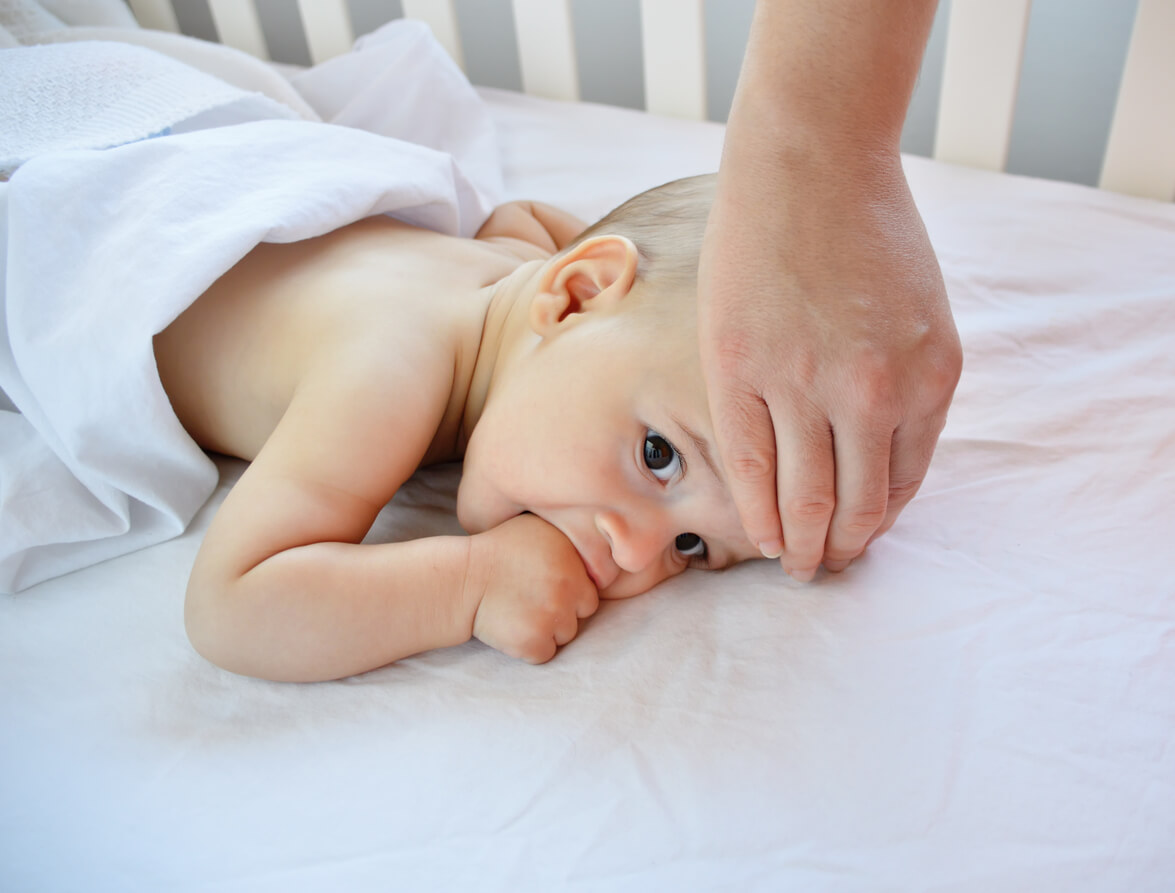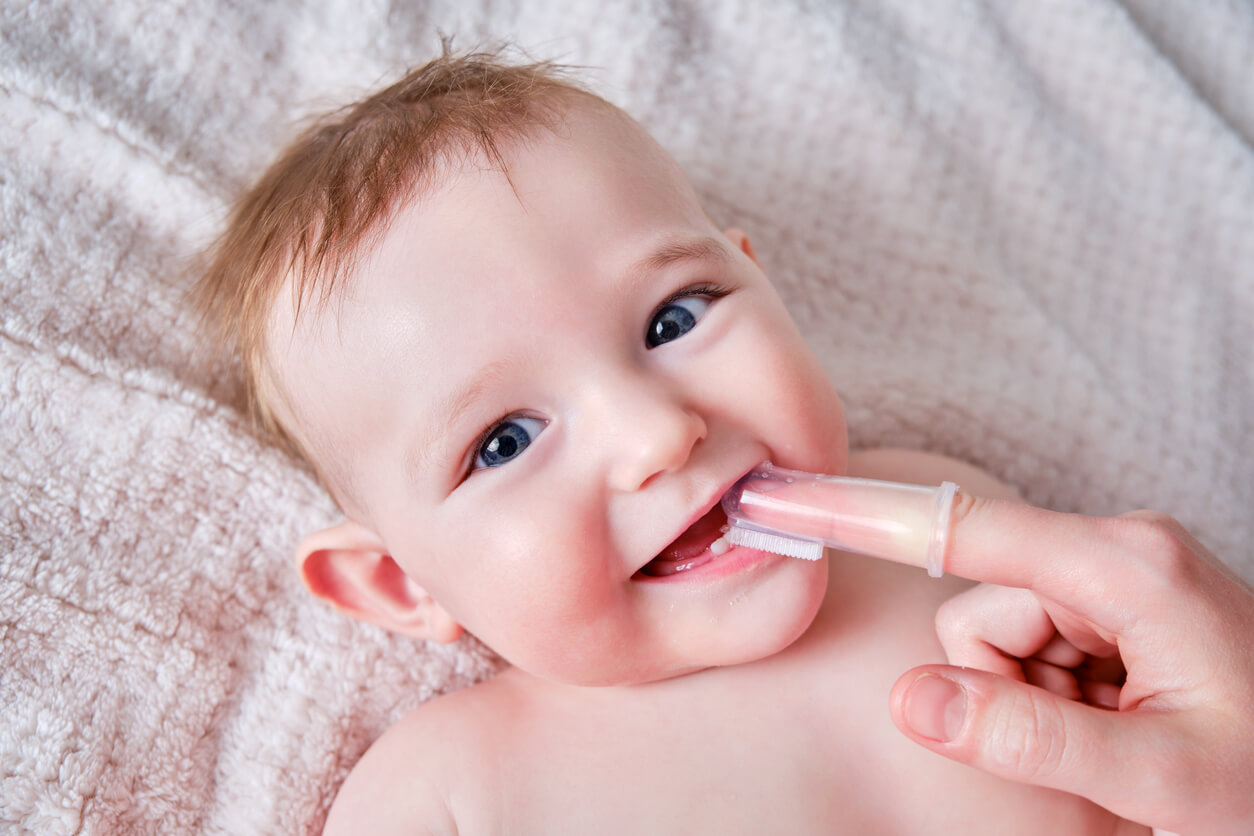6 Myths About the Appearance of the First Teeth


Written and verified by the dentist Vanesa Evangelina Buffa
There are many popular beliefs that attempt to explain certain events in the growth of the little ones. So there are different myths about the appearance of the first teeth, but is there any truth behind them? In this article, we’ll identify the most common sayings about the appearance of baby teeth. In addition, we’ll clarify if what they say is true.
1. When a baby drools a lot it is because the teeth are about to appear
It’s common to hear this phrase that relates the excessive drooling of little ones with the early appearance of the teeth. However, the truth is that there’s no real association between salivation and the appearance of teeth.
Babies’ salivary glands become active around 2 or 3 months of age. At this age, little ones don’t yet know how to swallow so much of the fluid, and that’s why it spills out. On the other hand, teeth usually erupt only after 4 or 6 months of age. Therefore, the excessive secretion of saliva occurs independently of the eruption of teeth.
It may happen that, in some babies, drooling coincides with an early appearance of teeth, but this isn’t the most common of cases. Keep in mind that children can drool for many months before their first teeth appear.
2. Tooth eruption causes fever
Believing that the eruption of teeth causes fever is another myth about the appearance of the first teeth. Therefore, relying on this belief can be dangerous, as it can lead parents to relax and not look for the real cause of the increase in their child’s temperature.
In some cases, small children may have a low-grade fever, which is an increase in temperature that doesn’t exceed 99.5 °F. But a fever higher than these values is due to some other process, so it’s important to consult with a pediatrician.

3. The appearance of the first teeth causes digestive problems and diarrhea
This is one of the myths about the appearance of the first teeth with which we must be cautious. Keep in mind that this process doesn’t cause diarrhea, colds, rashes, or other digestive problems.
It’s common for babies to put objects in their mouths and for germs to be accidentally introduced and cause digestive problems. The ability to swallow more saliva and the incorporation of new foods may also be responsible for diarrhea. Rashes and irritation in the diaper area may be due to frequent or very liquid stools.
4. They put everything in their mouth because they’re teething
The truth is that babies put everything in their mouths because it’s their way of exploring the world, whether they’re teething or not. In the oral cavity, there are many nerve endings through which they perceive information about the size, shape, textures, and consistency of things. Therefore, little ones begin to discover and get to know everything around them.
However, it’s also true that at the time of tooth eruption, little ones may put things in their mouths to soothe the discomfort of the eruption process. This is because firm, hard, and cold objects relieve the inflammation and sensitivity of the gums.
5. If the teeth take a long time to erupt, it’s because there’s a problem
Assuming that there’s a problem that’s causing the delay of the dental eruption is a mistake, as each child has their own time when it comes to the eruptive process, just like any other developmental milestone. In this regard, it’s considered normal for little ones to start the process between 4 and 8 months, as well as the completion of the same between 20 and 30 months.
Therefore, if the estimated time passes and the teeth don’t appear, don’t assume that the child has a developmental problem, lack of calcium, or growth retardation. You only need to wait, as eruption is variable. If close to the first year, no teeth appear, you can consult your pediatrician to determine if there’s a problem that may be causing the delay.

6. There’s no need to clean a baby’s first teeth
This is another of the myths about the appearance of the first teeth that can put the child’s health at risk. Being too relaxed with the care of the mouth is a danger for little ones. All teeth are susceptible to cavities. They can even present themselves in the form of baby bottle syndrome or early childhood cavities, an aggressive and rapidly advancing form.
Brushing should begin as soon as the first tooth erupts. In addition, you should avoid harmful practices such as tasting the child’s food, putting them to bed with the bottle in their mouth, giving them sugary drinks, and dipping pacifiers and teats in honey or sweets.
Accompany the teething process without believing in myths about the appearance of the first teeth
Now, you know that much is said about the process of tooth eruption, but not everything is as true as it might seem. Relying on these beliefs can even put your little one at risk. It’s true that the process for many children is uncomfortable, as the gums become swollen and sensitive. For this reason, the child may be irritable, nervous, angry, and even unable to sleep well.
It’s essential to accompany the child during this stage with a lot of affection and patience. Offering cold foods or foods with hard textures that soothe their gums is a good idea. Refrigerated teethers with different consistencies can also help. Even massaging the gums and oral hygiene time will soothe the uncomfortable sensations.
Also, taking your child to the pediatric dentist before their first birthday is the most advisable thing to do. Even if there’s no apparent problem, the professional will be able to evaluate the state of the mouth and advise parents on the necessary care. Your closeness and responsible accompaniment will help the child to experience it in the best way possible.
There are many popular beliefs that attempt to explain certain events in the growth of the little ones. So there are different myths about the appearance of the first teeth, but is there any truth behind them? In this article, we’ll identify the most common sayings about the appearance of baby teeth. In addition, we’ll clarify if what they say is true.
1. When a baby drools a lot it is because the teeth are about to appear
It’s common to hear this phrase that relates the excessive drooling of little ones with the early appearance of the teeth. However, the truth is that there’s no real association between salivation and the appearance of teeth.
Babies’ salivary glands become active around 2 or 3 months of age. At this age, little ones don’t yet know how to swallow so much of the fluid, and that’s why it spills out. On the other hand, teeth usually erupt only after 4 or 6 months of age. Therefore, the excessive secretion of saliva occurs independently of the eruption of teeth.
It may happen that, in some babies, drooling coincides with an early appearance of teeth, but this isn’t the most common of cases. Keep in mind that children can drool for many months before their first teeth appear.
2. Tooth eruption causes fever
Believing that the eruption of teeth causes fever is another myth about the appearance of the first teeth. Therefore, relying on this belief can be dangerous, as it can lead parents to relax and not look for the real cause of the increase in their child’s temperature.
In some cases, small children may have a low-grade fever, which is an increase in temperature that doesn’t exceed 99.5 °F. But a fever higher than these values is due to some other process, so it’s important to consult with a pediatrician.

3. The appearance of the first teeth causes digestive problems and diarrhea
This is one of the myths about the appearance of the first teeth with which we must be cautious. Keep in mind that this process doesn’t cause diarrhea, colds, rashes, or other digestive problems.
It’s common for babies to put objects in their mouths and for germs to be accidentally introduced and cause digestive problems. The ability to swallow more saliva and the incorporation of new foods may also be responsible for diarrhea. Rashes and irritation in the diaper area may be due to frequent or very liquid stools.
4. They put everything in their mouth because they’re teething
The truth is that babies put everything in their mouths because it’s their way of exploring the world, whether they’re teething or not. In the oral cavity, there are many nerve endings through which they perceive information about the size, shape, textures, and consistency of things. Therefore, little ones begin to discover and get to know everything around them.
However, it’s also true that at the time of tooth eruption, little ones may put things in their mouths to soothe the discomfort of the eruption process. This is because firm, hard, and cold objects relieve the inflammation and sensitivity of the gums.
5. If the teeth take a long time to erupt, it’s because there’s a problem
Assuming that there’s a problem that’s causing the delay of the dental eruption is a mistake, as each child has their own time when it comes to the eruptive process, just like any other developmental milestone. In this regard, it’s considered normal for little ones to start the process between 4 and 8 months, as well as the completion of the same between 20 and 30 months.
Therefore, if the estimated time passes and the teeth don’t appear, don’t assume that the child has a developmental problem, lack of calcium, or growth retardation. You only need to wait, as eruption is variable. If close to the first year, no teeth appear, you can consult your pediatrician to determine if there’s a problem that may be causing the delay.

6. There’s no need to clean a baby’s first teeth
This is another of the myths about the appearance of the first teeth that can put the child’s health at risk. Being too relaxed with the care of the mouth is a danger for little ones. All teeth are susceptible to cavities. They can even present themselves in the form of baby bottle syndrome or early childhood cavities, an aggressive and rapidly advancing form.
Brushing should begin as soon as the first tooth erupts. In addition, you should avoid harmful practices such as tasting the child’s food, putting them to bed with the bottle in their mouth, giving them sugary drinks, and dipping pacifiers and teats in honey or sweets.
Accompany the teething process without believing in myths about the appearance of the first teeth
Now, you know that much is said about the process of tooth eruption, but not everything is as true as it might seem. Relying on these beliefs can even put your little one at risk. It’s true that the process for many children is uncomfortable, as the gums become swollen and sensitive. For this reason, the child may be irritable, nervous, angry, and even unable to sleep well.
It’s essential to accompany the child during this stage with a lot of affection and patience. Offering cold foods or foods with hard textures that soothe their gums is a good idea. Refrigerated teethers with different consistencies can also help. Even massaging the gums and oral hygiene time will soothe the uncomfortable sensations.
Also, taking your child to the pediatric dentist before their first birthday is the most advisable thing to do. Even if there’s no apparent problem, the professional will be able to evaluate the state of the mouth and advise parents on the necessary care. Your closeness and responsible accompaniment will help the child to experience it in the best way possible.
All cited sources were thoroughly reviewed by our team to ensure their quality, reliability, currency, and validity. The bibliography of this article was considered reliable and of academic or scientific accuracy.
- Morett, Alfredo Espinosa, and Beatriz Anzures López. “Dentición primaria infantil. Mitos y realidades.” Revista Médica del Hospital General de México 66.1 (2003): 43-47.
- Herrero Solano, Yosvany, et al. “Manifestaciones clínicas durante el brote dentario e influencia de la lactancia maternal.” Multimed 23.2 (2019): 297-309.
- Ayala Pérez, Yolanda, Leyanis de la Caridad Carralero Zaldívar, and Beatriz del Rosario Leyva Ayala. “La erupción dentaria y sus factores influyentes.” Correo Científico Médico 22.4 (2018): 681-694.
- Alata Anamaría, Rolando. “Desarrollo y erupción dental.” (2019).
- Zambrano López, Johanna Antonella. Caries de la infancia temprana 1. BS thesis. Universidad de Guayaquil. Facultad Piloto de Odontología, 2020.
- Arévalo Manzaba, Lisbeth Stephania. Factores de riesgo asociados a la caries de la infancia temprana. BS thesis. Universidad de Guayaquil. Facultad Piloto de Odontología, 2019.
- De Rossi, Andiara, et al. “Odontología para bebés: una posibilidad práctica de promoción de salud bucal.” Revista de Odontopediatría Latinoamericana 7.2 (2020): 116-126.
- Hernández Bárcenas, Karen Alexia, et al. “Prácticas de higiene oral en niños de 0 a 36 meses de edad.”
This text is provided for informational purposes only and does not replace consultation with a professional. If in doubt, consult your specialist.








